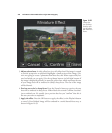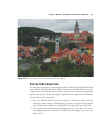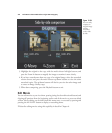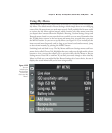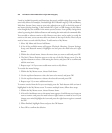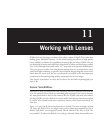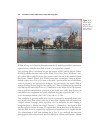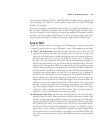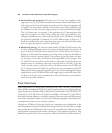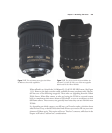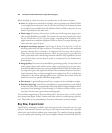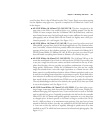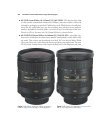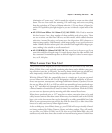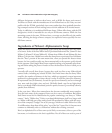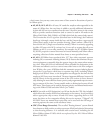
■ Lack of wide-angle perspective. Of course, the 1.5X “crop” factor applies to wide-
angle lenses, too, so your 20mm ultrawide lens becomes a hum-drum 30mm near-
wide-angle, and a 35mm focal length is transformed into what photographers call
a “normal” lens. Zoom lenses, like the 18-105mm lens that is often purchased with
the D7000 in a kit, have less wide-angle perspective at their minimum focal length.
The 18-105mm optic, for example, is the equivalent of a 27mm moderate wide
angle when zoomed to its widest setting. Nikon has “fixed” this problem by pro-
viding several different extra-wide zooms specifically for the DX format, including
the (relatively) affordable 10-24mm f/3.5-4.5 DX Nikkor shown in Figure 11.2.
You’ll never really lack for wide-angle lenses, but some of us will need to buy wider
optics to regain the expansive view we’re looking for.
■ Mixed body mix-up. The relatively small number of Nikon D7000 owners who
also have a Nikon full-frame camera can’t ignore the focal-length mix-up factor. If
you own both FX and DX-format cameras (some D7000 owners use them as a
backup to an FX model, for example), it’s vexing to have to adjust to the different
fields of view that the cameras provide. If you remove a given lens from one cam-
era and put it on the other, the effective focal length/field of view changes. That
17-35mm f/2.8 zoom works as an ultra-wide to wide angle on an FX camera, but
functions more as a moderate wide-angle to normal lens on a D7000. To get the
“look” on both cameras, you’d need to use a 10-24mm zoom on the D7000, and
the 17-35mm zoom on the D700. It’s possible to become accustomed to this FOV
shake-up and, indeed, some photographers put it to work by mounting their longest
telephoto lens on the D7000 and their wide-angle lenses on their full-frame cam-
era. But, even if you’ve never owned both an FX and DX camera, you should be
aware of the possible confusion.
Your First Lens
Some Nikon dSLRs are almost always purchased with a lens. The entry- and mid-level
Nikon dSLRs, including the D7000, are often bought by those new to digital photog-
raphy, frequently by first-time SLR or dSLR owners who find the AF-S DX Nikkor 18-
105mm f/3.5-5.6G ED VR or AF-S DX Zoom-Nikkor 18-55mm f/3.5-5.6G ED II,
both with vibration reduction, irresistible bargains. Other more advanced Nikon mod-
els are often purchased without a lens by veteran Nikon photographers who already have
a complement of optics to use with their cameras.
I bought my D7000 as a body-only (which was a somewhat rare configuration at the
time of introduction), because I already had a (large) collection of lenses. But you might
have purchased your D7000 with a lens, because it’s an excellent first Nikon camera for
photographers experienced with another camera line, or for ambitious beginners. That
makes an economical “kit” lens very attractive. When the D7000 was first introduced,
David Busch’s Nikon D7000 Guide to Digital SLR Photography348



